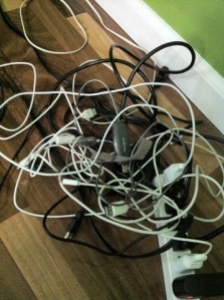After Donald Maass spoke about how to intensify novels and convinced everyone that the novels they came to New York to pitch needed to be rewritten from scratch, we were treated to the last speaker of the evening, Chuck Sambuchino, who gave us a crash course in pitching a novel.
Chuck summed up the novel pitch like this: It is the back of a DVD box.
You start with a logline. This is a one-sentence hook to draw in your readers to checking out your title instead of that book of 101 pranks that can be performed with fruit. Can love survive tragedy? What do you do when the world’s most wanted terrorist is also your mother?
Then you move on to the pitch itself. A pitch, Chuck explained, is a three to ten sentence description of your manuscript. Three to ten sentences to get the attention of an agent. Three to ten sentences that determine whether you are going to become a published author or spend the rest of your life working customer service at Harvey’s House of Milk.
The pitch is supposed to take between 60 and 90 seconds to deliver, or between 5 and 8 seconds if you talk like that guy who did the commercials for Micro Machines. It begins with a sentence that introduces your main character, preferably by name, that sums up the status quo:
Frank thought he had found the perfect job as a taste tester for Lucky Charms.
Next, a sentence or two that sum up how that status quo is disrupted:
But one day he sees a marshmallow that he has never seen before. It is black and in the shape of a PlayStation controller.
Then, a few sentences about how the main character confronts that disruption to the status quo:
At first, Frank thinks it is just an accident. But as these black PlayStation controller marshmallows keep showing up in his assignments, he starts to ask questions, and finds that these new additions are more than just a test. Rebuffed by his superiors, Frank digs deeper and finds himself embroiled in the middle of a worldwide conspiracy to enslave the eaters of sugary cereals.
Finally, close with a sentence that shows how the main character grows as a consequence of confronting the disruption to his status quo, but that does not give away the ending. It helps if you can throw in a sidekick and a romantic interest:
Aided by an animated leprechaun—and motivated by his newly found love for the mysterious Wanda Slapjankles—Frank learns that breakfast cereal is more than just for breakfast.
And that’s it! Now you try.






